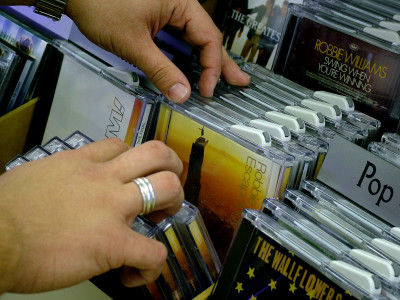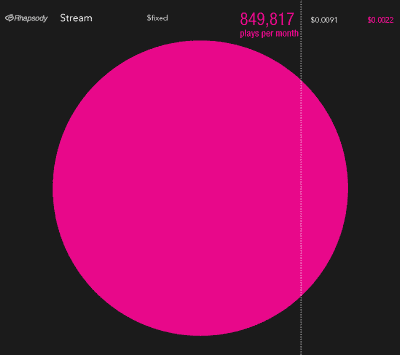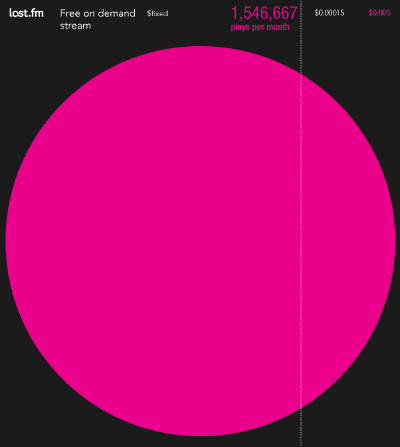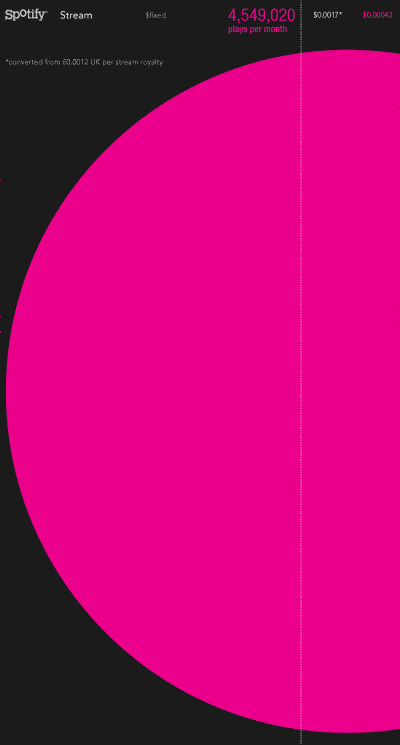How many songs can an artist have to live online? Figure representing

It seems that the mechanism of selling only digitized music data, not media such as records and CDs, has become commonplace.
This system, which reduces various costs such as production and distribution, sells songs from albums individually, and makes it possible for artists who do not belong to major labels to publish their works at low cost, is a measure for us consumers. There are unknown merits, but what does it look like from the perspective of the artist who provides the music?
Details are below.
How Much Do Music Artists Earn Online?
This figure is a circle showing how much you need to sell each month to get the US minimum wage of $ 1,160. In the graph on the right, gray is the label and pink is the artist's profits.
Also, since this is a trial calculation for a 'singer of solo activity', for example, a band of four people needs to sell four times this amount, or a singer-songwriter who writes songs and lyrics by himself. Since the royalties are also paid, the amount is small and there are some errors.
In the case of a self-published album CD, if you sell it for $ 9.99 (about 930 yen), the profit per sheet will be $ 8, and the minimum wage will be achieved with 143 sheets.

If you start out as a company specializing in self-published CDs and sell your own CDs through

If you belong to a label and have a 2: 1 profit share, $ 2 of the $ 9.99 selling price will be for the label, $ 1 will be for the artist, and you will need 1161 copies to reach your goal.

When downloading and selling an album via Napstar (via iTunes), if the selling price is $ 9.99, 6.29 cents of the profit will be distributed to the label, 94 cents will be the artist's share, and 1229 downloads will be required. ..

If you download a single song from cdbaby and sell it for 99 cents (about 92 yen) per song, the artist's share is 74 cents. You will reach your goal with 1562 downloads. Considering that one album contains an average of 12 songs, this is equivalent to about 130 songs.

When buying from cdbaby via iTunes, the artist's share is 57 cents and the goal is achieved with 2044 downloads. It is equivalent to about 170 albums containing 12 songs.

If you belong to a label and make a profit distribution of 20: 3, $ 2 of the selling price of $ 9.99 will be the label's share, 30 cents will be the artist's, and if you sell 3871 copies, you will clear the target.

If this is a single song sale on Amazon (via iTunes), the Amazon's share is 63 cents and the artist's share is 9 cents for 99 cents per song, achieving the goal by downloading 12399 songs. An album with 12 songs for 1033 pieces.

By the way, if it is a streaming sale that does not store the data at hand, the numbers will swell.

When users register their music preferences,


This is the overall view including other sales methods.

You can also see the original data here.
Musician Digital Royalties
Of course, it is also possible that online sales will increase consumers' purchasing motivation, and that the so-called 'long tail' effect will generate ultra-long-term sales. This is certainly a benefit for sales sites and labels. But from the artist's point of view, no one can answer whether this really reduces the burden.
The theory that 'selling things online eliminates intermediate exploitation and makes creators happy' can be found not only in music but also in all fields that can be digitized, such as movies, anime, and books. But I think we need to wonder if the creators will really be happy.
12:41 2010/04/23 Added other data
Related Posts:
in Web Service, Posted by darkhorse_log







